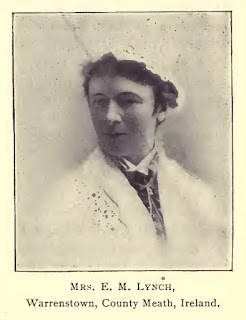This article appears in this month's Giuliana Ricama in Italy so if you'd like to read it in Italian, you can find it there.
Towards the end of the 19th century an educated and cultured Irish lady from a good and rather important family passed her summers, perhaps for health reasons, in the Alps. She travelled all the way to the Val Vogna, a small Piedmontese valley and fell in love with the place. She particularly admired it's hardworking women who, left alone for many months of the year while their men were working in France, looked after their families in great poverty. A fire destroyed one of the small hamlets and the lady had a generous idea which, for the valley, turned out to be a brilliant one. She gave the hamlet the money to reconstruct the few houses and animal stalls and as repayment she asked for pieces and lengths of the local Puncetto needle lace. Returning home to Ireland she was able to sell all the lace to her friends and many acquaintances. She arrived the next time in Piedmont with orders for more items and started up the Valvognian Industry with it's base of operations in Ca' Verno (Riva Valdobbia). She worked with the help of Agata Maria Teresa (Marietta) Frascotti Favro (1841-1899), an elementary school teacher, who had taught the working of Puncetto in the surrounding area, and who was the wife of the owner of Casa Janzo (Riva Valdobbia), the hotel where the Irish lady stayed during the summer. Clorinda Barile Favro (1877-1962), a pupil of Marietta, managed the business activity of the Valvognian Industry. In this way the women of the valley started to earn with the Puncetto that they made.
 |
|
A few lacemakers from the Valvognian Industry including Aurelia Barile,
Teresa, Carolina and Maria Andoli and Clorinda Favro. |
The Irish lady, a great traveller, used her numerous connections to sell the lace. The business grew and came to include the working of other types of lace and embroidery on Irish linen. In this way they helped to relieve some Irish poverty as well. Through a barrage of articles in newspapers and women's magazines in England, Europe and also in the U.S. and through orders taken during national and international expositions, the women of the Val Vogna experienced a period of very productive business and unexpected comfort.
 |
| Eliza Matilda Johnson Lynch 1846-1917. Catholic World, 1897, vol. 66, n. 391, p. 137. |
Over the last century there has been much misinformation about the Irish lady. Legend and myth became fact and when facts were not known, unfortunately for history, they were invented. She signed herself E. M. Lynch, and this has created much confusion. Through the advent of periodicals online and great genealogy websites, today we can finally get a few clearer ideas. The most important one is her name. She was called Eliza Matilda Johnson. Born in 1846 in Ireland, she then married Captain Edward Aloysius Lynch in 1866. Eliza was a suffragette and was active in England, making speeches and participating in campaigns for women's rights. She wrote articles for many magazines and newspapers on social problems, travelling and the uses and folk costumes of the countries she visited. She even wrote a bit of fiction. In Davos, Switzerland in 1901 she published a small volume called “Valle Vogna and its lace industry” collecting images and many articles which had appeared in newspapers and magazines about her business in Val Vogna. A second edition (1905) of this little book can be found among the book collection of the Italian scholar Elisa Ricci. The collection is now held by the Civic Central Library in Turin, Italy. Another copy of the second edition, with a dedication written by Mrs. Lynch can be found in the Thomas J. Watson Library of the Metropolitan Museum in New York. An Italian version was translated and printed by the Walser Gmai of Alagna Valsesia in Piedmont in 1992. After the death of her husband in 1899, Eliza continued to travel to Italy and other parts of Europe. In her later years, she settled in Sanremo in Liguria. She died in Triora (Liguria) on the 8th of September 1917. There is still much to learn about this Irish lady and her activities. This is the beauty of research in the world of Italian embroidery and lace: I never stop investigating, discovering and learning.
